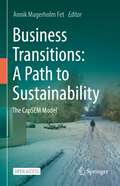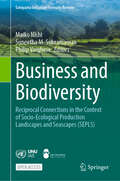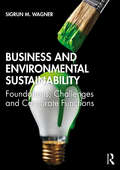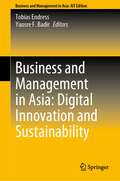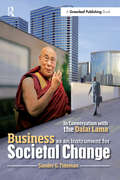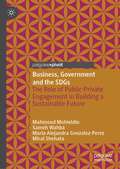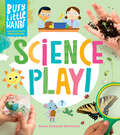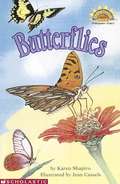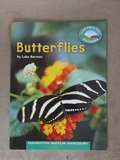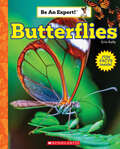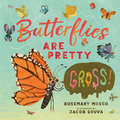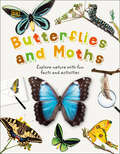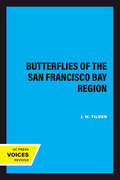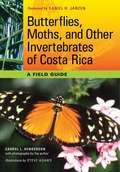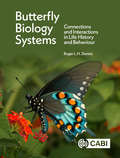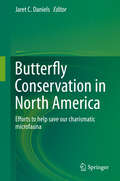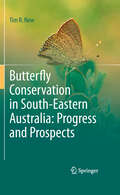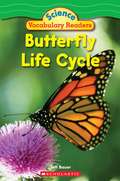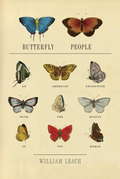- Table View
- List View
Business Transitions: The CapSEM Model
by Annik Magerholm FetThis open access book represents a journey documenting the development of tools and methodologies over 3 decades and asks where the future lies. It further develops seminal work carried out under the auspices of the Capacity building in Sustainability and Environmental Management (CapSEM) project co-funded by the EU Erasmus programme from 2016-2019 as well as research projects such as IGLO-MP2020, SUSPRO, and SISVI. It gathers existing paradigms of environmental management within the relevant frameworks which have driven the way in which this discipline has developed. It seeks to both challenge and support the way in which business sectors have approached this previously, with a more holistic and overarching model being provided, moving through four very distinct levels. It therefore provides not only a different approach, but a different way of thinking. Systems thinking is characterized by four levels: Process, Product Value Chain, Organisational and Systemic which combines Material Flow Analysis (MFA), Life Cycle Assessment (LCA), Corporate Social Responsibility (CSR) and Industrial Ecology (IE) principles. In its practical application, Corporate Social Responsibility, for example, thus becomes an integral part of a much wider business strategy and impacts on all business activity, not added value for its own sake, but a valuable component in a wider toolbox as a fundamental part of any business strategy and plan, changing, flexing and developing over the years. The book is divided into 4 parts: moving from context and background, to the theoretical model or toolbox, onto its practical application in case studies and culminates in looking at the future and potential developments. It represents the multi-disciplined collaboration at NTNU and beyond, exemplifying its use in a wealth of business sectors and a range of stakeholders from construction to textiles to wind power as outlined in the European Circular Action Plan.
Business and Biodiversity: Reciprocal Connections in the Context of Socio-Ecological Production Landscapes and Seascapes (SEPLS) (Satoyama Initiative Thematic Review)
by Maiko Nishi Suneetha M. Subramanian Philip VargheseThis open access book presents useful knowledge and lessons that derive from on-the-ground activities and contributes to policy recommendations, focusing on the reciprocal connections between business and biodiversity in the context of social-ecological production landscapes and seascapes (SEPLS). It introduces a set of concrete examples demonstrating the relevance of SEPLS to aspects of reciprocal connections between business and biodiversity. The case studies highlight the roles, attitudes, motivations, and actions of multiple stakeholders in conserving biodiversity while providing other benefits that directly or indirectly contribute to businesses. They also illustrate on-the-ground impacts of businesses in SEPLS – including positive and negative ones, providing insights on how to categorize and measure the impacts and dependency of businesses on biodiversity and nature’s contributions to people. This will help facilitate policy learning and evidence-based decision-making to promote the achievement of global goals including the Kunming-Montreal Global Biodiversity Framework and the sustainable development goals (SDGs). Many of the case studies concerning SEPLS management derived from the International Partnership for the Satoyama Initiative (IPSI) provide rich evidence to detail and help clarify the interdependency between businesses and biodiversity while exemplifying innovative solutions to facilitate more sustainable business decisions and actions for socially and ecologically sound outcomes. Furthermore, the experiences in managing SEPLS where multiple actors negotiate and collaborate to meet diverse needs and interests provide practical insights on the roles and responsibilities of stakeholders and how to build partnerships to promote systemic changes towards sustainable futures. The book provides key messages derived from a synthesis of the case study findings, which will help stakeholders including policymakers, scientists, and practitioners to deepen the understanding of reciprocal connections between business and biodiversity and clarify challenges and opportunities for promoting more sustainable businesses and at the same time safeguarding biodiversity and ecosystems. This in turn will help further the science-policy-practice interfaces related to biodiversity, ecosystem services, and sustainable development.
Business and Environmental Risks: Spatial Interactions Between Environmental Hazards and Social Vulnerabilities in Ibero-America
by Diego A. Vazquez-Brust Claudia E. Natenzon Jerónimo de Burgos-Jiménez José A. Plaza-ÚbedaBased on detailed research funded across two continents and involving universities in Argentina, Spain and the UK, this book sets out an innovative, multidisciplinary approach to assessing both environmental and social risks in a given territorial area. Using data from a number of Ibero-American nations, the study combines environmental, socio-economic and geographic factors to construct a set of spatial and technical indicators that measure the social vulnerability and industrial hazardousness of a defined area. Aggregating these indicators in a geographic information system (GIS) allows researchers to assess the potential risk to which a certain area and its population are subject as a result of the environmental deterioration caused by co-located industrial activity.
Business and Environmental Sustainability: Foundations, Challenges and Corporate Functions
by Sigrun M. WagnerEnvironmental sustainability is increasingly important to organisations, whether for regulatory, financial or ethical reasons. Business and Environmental Sustainability looks at the environmental aspect of sustainability for all organisations pursuing competitive advantage. The book provides theoretical foundations from science, economics, policy and strategy, introduces three environmental challenges (climate change, pollution and waste) and looks at how corporate functions can address these. This textbook provides a thorough foundation by introducing readers to the science, reasoning and theory behind environmental sustainability and then delves into how these ideas translate into principles and business models for organisations to use. Next, it covers environmental challenges from climate change, pollution and waste, and then goes on to examine the different corporate functions (from supply chain management to human resources) to illustrate how environmental sustainability is managed and put into practice in organisations. Finally, a set of integrative case studies draws everything together and enables the reader to apply various analytical tools, with the aim of understanding how companies can not only reduce their environmental footprint but can positively contribute to environmental sustainability. Written by an award-winning lecturer, Business and Environmental Sustainability boasts a wealth of pedagogical features, including examples from a range of industries and countries, plus a companion website with slides, quiz questions and instructor material. This will be a valuable text for students of business, management and environmental sustainability and will also be suitable for broader courses on corporate responsibility and sustainability across environmental studies, political science and engineering.
Business and Management in Asia: Digital Innovation and Sustainability
by Tobias Endress Yuosre F. BadirThis book focuses on digital innovation and sustainability in the Asian region in the context of business and management. Managers and policy makers rely on digital technologies to face the region’s sustainability challenges and solve sustainability problems. From business perspective, sustainability is defined as the adoption of business strategies, activities, and operations that meet the needs of the firm and its stakeholder today while protecting, sustaining, and enhancing the human and natural resources that will be needed in the future. Digital innovation refers to the application of digital technologies to existing business problems as well as the development of the firm’s strategy, culture, and human resources talent to deal and use digital technologies to solve sustainability issues. There is a consensus among scholars and practitioners that organizations need digital innovation to stay competitive. Businesses that are digital innovators consider new ways to solve old and new sustainability problems facing the Asian region. This book, with its practical examples, gives the reader impulses for new Asian’s approaches and encourages the readers to dare to think and act in new ways. This book is the first annual compilation of innovative ideas and valuable managerial solutions produced by the region’s managers and decision-makers who think and act creatively, helmed by Tobias Endress and Yuosre F. Badir from the School of Management at the Asian Institute of Technology.
Business as an Instrument for Societal Change: In Conversation with the Dalai Lama
by Sander TidemanBusiness as an Instrument for Societal Change: In Conversation with the Dalai Lama is the result of two decades of research and dialogue with His Holiness the Dalai Lama and other leaders in business, government, science and education. Author Sander Tideman, a lawyer and banker who has maintained a friendship with the Dalai Lama over all these years, presents a practical framework and methodology to develop a new kind of leadership - one fit to repurpose the business world and tackle escalating social, economic and environmental needs. The Dalai Lama rarely speaks directly on the topics of business, leadership and economics. Yet in the dialogues recounted here, his wisdom - combined with key insights from business and public leaders -creates a unified shift towards a consciousness of interconnectedness, offering profound insights for practitioners and general readers alike. Tideman unites the scientific worldviews of physics, neuroscience and economics with the positive psychology of human relationships, and ancient spiritual wisdom, to formulate practical business leadership solutions. While recognizing the need for change in external structures and governance, Tideman highlights the importance of opening our minds, and connecting inner and outer spirituality. At the same time, he focuses on concrete practices for winning the hearts and minds of employees, customers, communities, and society at large, while addressing deep-rooted problems such as extreme social inequality and continued financial collapses. At the heart of this book lies the journey to discover our shared purpose. This ignites new sources of value creation for the organisation, customers and society, which Tideman terms 'triple value'. We can achieve triple value by aligning societal and business needs, based on the fundamental reality of interconnection. Business as an Instrument for Societal Change: In Conversation with the Dalai Lama is a readable and intelligent exploration of how leaders can actually help to shape a sustainable global economy by embracing innate human and humane behaviour. It is also Tideman's fascinating personal journey, which brought him to question the underlying motivations and goals of business leadership and to seek a new paradigm for a more sustainable approach. Reflecting Tideman's sharp perceptions and infused with the Dalai Lama's unmistakable joy, this book has the power to change your way of thinking.
Business, Government and the SDGs: The Role of Public-Private Engagement in Building a Sustainable Future
by Sameh Wahba Maria Alejandra Gonzalez-Perez Mahmoud Mohieldin Miral ShehataThis book seeks to revise and challenge the roles and traditional realms of influence that national and local governments, and businesses at a critical juncture in terms of achieving sustainable development, faces when tackling the dual challenges of climate change and post-COVID recovery. Using the broader lens of the 2030 UN Sustainable Development Goals (SDGs) to assess the roles and responsibilities of each of these stakeholders and their relationships, the book offers policy, economic arguments, case studies and examples to argue that neither national or local governments, nor companies, could afford to deviate from the SDGs in the recovery from the current crisis, nor that the imperative of bold climate action should detract from the broader focus on sustainability. The analysis frames the debate of how a balance between people, planet, and profits can be achieved and how nations, regions and cities, and businesses, with their representative organizations, can achieve a sustainable recovery from the current global crisis, and contribute to climate smart, resilient and inclusive development.
Business, Human Rights and the Environment: The Evolving Agenda
by Chiara MacchiMore than ten years after the adoption of the UN Guiding Principles on Business and Human Rights, this book critically reviews the achievements, limits and next frontiers of business and human rights following the ‘protect, respect, remedy’ trichotomy. The UN Guiding Principles acted as a catalyst for hitherto unprecedented regulatory and judicial developments. The monograph by Macchi proposes a functionalist reading of the state’s duty to regulate the transnational activities of corporations in order to protect human rights and adopts a holistic approach to the corporate responsibility to respect, arguing that environmental and climate due diligence are inherent dimensions of human rights due diligence. In the volume emerging legislations are assessed on mandatory human rights and environmental due diligence, as well as the potential and limitations of a binding international treaty on business and human rights. The book also reviews groundbreaking litigation against transnational corporations, such as Lungowe v. Vedanta or Milieudefensie v. Shell, for their human rights and climate change impacts. The book is primarily targeted at academic and non-academic legal experts, as well as at researchers and students looking at business and human rights issues through the lenses of legal studies (particularly international law and European law), political sciences, business ethics, and management. Additionally, it should also find a readership among practitioners working in the public or private sector (consultants, CSR officers, legal officers, etc.) willing to familiarize themselves with the expanding areas of liability, financial and reputational risks connected to the social and environmental impacts of global supply chains.Chiara Macchi is currently Lecturer in Law at Wageningen University & Research in The Netherlands.
Busy Bees (Houghton Mifflin Reading Leveled Readers)
by Margaretha TakmarIn this story, you will learn about several kinds of bees.
Busy Body Sleep Solution
by Amy TaoEmma's having some trouble going to sleep. But with the help of Grammy's busy body sleep solution, she says goodnight to her hardworking body and drifts off to sleep.
Busy Little Hands: Learning Activities for Preschoolers (Busy Little Hands)
by Susan Edwards RichmondPreschoolers are introduced to core science concepts with this playful format featuring 20 hands-on activities that use everyday household materials, including a vinegar volcano, a hula hoop count, and a kitchen sink or swim experiment.
Butterflies
by Karen Shapiro Jean CasselsThis rhyming easy-to-read non-fiction science reader covers a favorite nature subject taught in the early childhood curriculum -- the metamorphosis of a caterpillar to a butterfly. "Butterflies start as tiny eggs. Out come caterpillars with many legs...."
Butterflies (Be an Expert!)
by Erin KellyKids love to be the experts! Now they can feel like real pros with this exciting nonfiction series for beginning readers. Kids will be hooked on the thrilling real-world topics and big, bright photos. Each book features simple sentences and sight words that children can practice reading. Then, with support, kids can dig deeper into the extra facts, Q&As, and fun challenges.Fans of this series will be eager to become real experts!Some are very colorful. Some are see-through. They are all beautiful! What do you know about butterflies like the monarch, the blue morpho, and the glasswing? With this book you can become an expert!
Butterflies Are Pretty ... Gross! (Nature's Top Secrets)
by Rosemary MoscoWarning -- this book contains top-secret information about butterflies! Prepare to be shocked and grossed out by this hilarious and totally true picture book introduction to a fascinating insect.Butterflies are beautiful and quiet and gentle and sparkly . . . but that's not the whole truth. Butterflies can be GROSS. And one butterfly in particular is here to let everyone know! Talking directly to the reader, a monarch butterfly reveals how its kind is so much more than what we think. Did you know some butterflies enjoy feasting on dead animals, rotten fruit, tears and even poop? Some butterflies are loud, like the Cracker butterfly. Some are stinky -- the smell scares predators away. Butterflies can be sneaky, like the ones who pretend to be ants to get free babysitting. This hilarious and refreshing book with silly and sweet illustrations explores the science of butterflies and shows that these insects are not the stereotypically cutesy critters we often think they are -- they are fascinating, disgusting, complicated and amazing creatures.
Butterflies and Moths: Explore Nature with Fun Facts and Activities (Nature Explorers)
by DKThe perfect companion for children eager to understand how caterpillars become butterflies.Explore butterfly habitats and find out all about how butterflies work, from wings to feet. With exciting activities, like how to make a butterfly kite, and plenty of fun facts, this book is a must for children curious about butterflies and moths.
Butterflies in Room 6: See How They Grow (Life Cycles in Room 6)
by Caroline ArnoldKindergarteners learn the joys of raising butterflies from egg to adult in this close-up look at the insect life cycle.A visit to Mrs. Best's classroom is always inspiring! Follow a classroom of real kindergartners as they participate in a popular classroom activity: raising butterflies. Astonishing photographs show the life cycle of the painted lady butterfly, from egg to caterpillar to chrysalis to adult. Engaging text captures the children's wonder and explains the science behind metamorphosis. The Life Cycles in Room 6 series follows Mrs. Best&’s real kindergarten class as they help things grow. This photo-illustrated series engages readers with hands-on science in the classroom and beyond.
Butterflies of Cyprus: A Field Guide and Distribution Atlas
by Eddie John Christodoulos MakrisThis new book summarises decades of research and collation of distributional data. From the tiny Freyeria trochylus (Grass Jewel), Europe's smallest butterfly, to the magnificent, newly arrived Papilio demoleus (Lime Swallowtail), this comprehensively illustrated reference book and field guide includes all butterfly species known in Cyprus over the past 100 years. Where applicable, reference is made to subspecies of related taxa present in nearby countries of the eastern Mediterranean. The images on the cover represent the island's seven endemics, discussed in depth. Included, too, are detailed distribution maps representing records garnered from almost 300 recorders/sources (particularly members of the Cyprus Butterfly Study Group), over a period of more than 20 years.
Butterflies of the San Francisco Bay Region (California Natural History Guides #12)
by J. W. TildenThis title is part of UC Press's Voices Revived program, which commemorates University of California Press’s mission to seek out and cultivate the brightest minds and give them voice, reach, and impact. Drawing on a backlist dating to 1893, Voices Revived makes high-quality, peer-reviewed scholarship accessible once again using print-on-demand technology. This title was originally published in 1965.
Butterflies, Moths, and Other Invertebrates of Costa Rica
by Carrol L. Henderson Daniel H. Janzen Steve AdamsAt the biological crossroads of the Americas, Costa Rica hosts an astonishing array of plants and animals-over half a million species! Ecotourists, birders, and biologists come from around the world, drawn by the likelihood of seeing more than three or four hundred species of birds and other animals during even a short stay. To help all these visitors, as well as local residents, identify and enjoy the wildlife of Costa Rica, Carrol Henderson published Field Guide to the Wildlife of Costa Rica in 2002, and it instantly became the indispensable guide. Now Henderson has created a dedicated field guide to more than one hundred tropical butterflies, moths, and other invertebrates that travelers are most likely to see while exploring the wild lands of Costa Rica. He includes fascinating information on their natural history, ecology, identification, and behavior gleaned from his forty years of travels and wildlife viewing, as well as details on where to see these remarkable and beautiful creatures. The butterflies, moths, and other invertebrates are illustrated by over 180 stunning and colorful photographs-most of which were taken in the wild by Henderson. A detailed and invaluable appendix that identifies many of Costa Rica's best wildlife-watching destinations, lodges, and contact information for trip-planning purposes completes the volume.
Butterfly Biology Systems: Connections and Interactions in Life History and Behaviour
by Roger L DennisIn Butterfly Biology Systems Roger Dennis explores key topics and contentious issues in butterfly biology, specifically those in life history and behaviour. Uniquely, using a systems approach, the book focuses on the degree of integration and feedback between components and elements affecting each issue, as well as the links between different issues. The book comprises four sections. The first two sections introduce the reader to principles and approaches for investigating complex relationships, and provide a platform of knowledge on butterfly biology. The final two sections deal in turn with life history and behaviour, covering key issues affecting different stages of development from eggs to adults. The book is extensively illustrated with original diagrams and models, all of which have detailed legends, produced to enhance a broader understanding, and to provide templates for future research. It includes a detailed bibliography and glossary providing an essential gateway to the extensive literature on butterfly biology. Butterfly Biology Systems is essential reading for graduate students and researchers in insect ecology, evolution, behaviour and conservation. It will also be of great value to anyone interested in butterflies. Introduces a systems approach to butterfly biology Includes succinct reviews of the key interrelationships in butterfly life history and behaviour Illustrates more than 100 models to advance research into butterfly biology systems
Butterfly Conservation in North America: Efforts to help save our charismatic microfauna
by Jaret C. DanielsThe book addresses this critical need by providing a straightforward and easy to read primer to key elements of at-risk butterfly conservation programs including captive husbandry, organism reintroduction, habitat restoration, population monitoring, recovery planning and cooperative programs. Impacts from habitat loss and fragmentation, invasive species, and climate change continue to accelerate the rate of imperilment and necessitate increased conservation action. Zoos, natural history museums, botanical gardens and wildlife agencies are progressively focusing on insects, particularly charismatic groups such as butterflies and native pollinators, to help advance local conservation efforts and foster increased community interest and engagement. Today, many institutions and their partners have successfully initiated at-risk butterfly conservation programs, and numerous others are exploring ways to become involved. However, insufficient experience and familiarity with insects is a critical constraint preventing staff and institutions from adequately planning, implementing and evaluating organism-targeted activities. The information provided is intended to improve staff practices, learn from existing programs, promote broader information exchange, and strengthen institutional ability to develop new or improve existing butterfly conservation initiatives. The information provided is intended to improve staff practices, learn from existing programs, promote broader information exchange, and strengthen institutional ability to develop new or improve existing butterfly conservation initiatives. This book will be useful to professionals from zoos, natural history museums, botanical gardens, wildlife agencies, conservation organizations, land managers, students, and scientist in conservation biology, ecology, entomology, biology, and zoology.
Butterfly Conservation in South-Eastern Australia: Progress And Prospects
by Tim R. NewA survey of the development and practice of butterfly conservation in south east Australia, tracing evolution of the science through a series of cases from focus on single subspecies through increasing levels of ecological complexity to critical biotopes and communities. The book summarises much previously scattered information, and provides access to much regional information of considerable interest to practitioners elsewhere.
Butterfly Life Cycle (Science Vocabulary Readers)
by Jeff BauerHave you ever seen a caterpillar? This book will show you how it becomes a beautiful butterfly!
Butterfly People
by William R. LeachWith 32 pages of full-color inserts and black-and-white illustrations throughout.From one of our most highly regarded historians, here is an original and engrossing chronicle of nineteenth-century America's infatuation with butterflies, and the story of the naturalists who unveiled the mysteries of their existence. A product of William Leach's lifelong love of butterflies, this engaging and elegantly illustrated history shows how Americans from all walks of life passionately pursued butterflies, and how through their discoveries and observations they transformed the character of natural history. Leach focuses on the correspondence and scientific writings of half a dozen pioneering lepidopterists who traveled across the country and throughout the world, collecting and studying unknown and exotic species. In a book as full of life as the subjects themselves and foregrounding a collecting culture now on the brink of vanishing, Leach reveals how the beauty of butterflies led Americans into a deeper understanding of the natural world. He shows, too, that the country's enthusiasm for butterflies occurred at the very moment that another form of beauty--the technological and industrial objects being displayed at world's fairs and commercial shows--was emerging, and that Americans' attraction to this new beauty would eventually, and at great cost, take precedence over nature in general and butterflies in particular.
